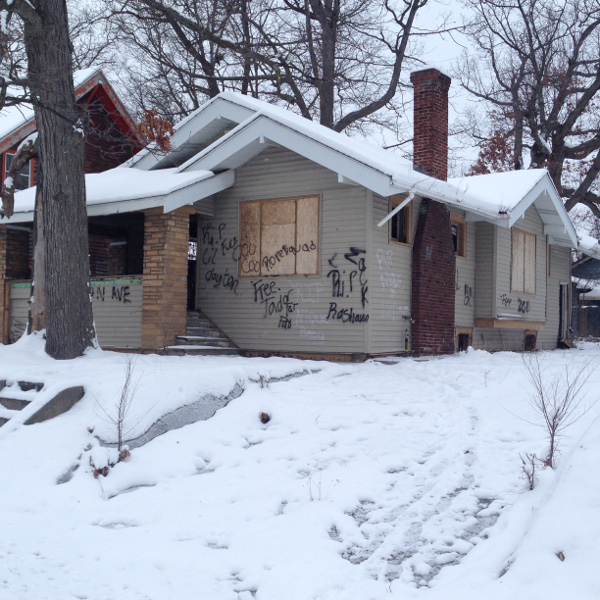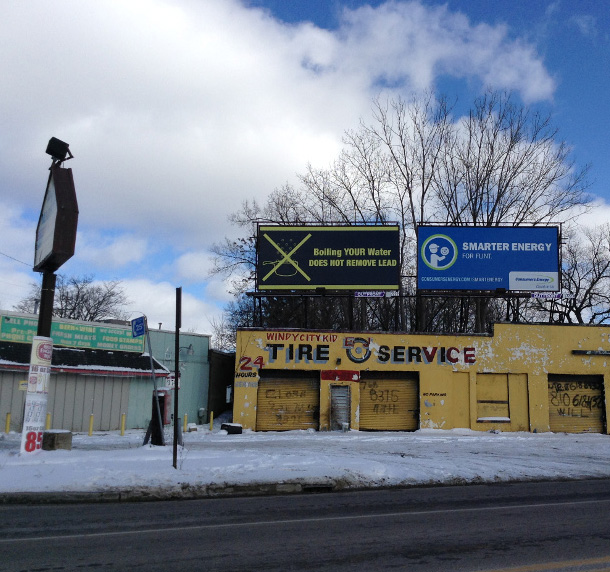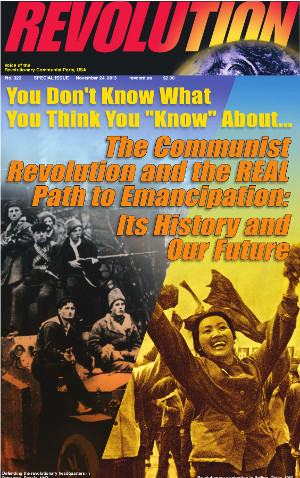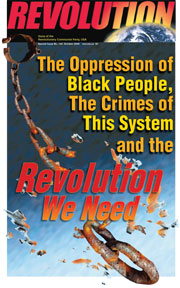Reporter's Notebook from Flint Part One
How the North Side Ghetto Became Ground Zero for Lead Poisoning
by Alan Goodman | February 29, 2016 | Revolution Newspaper | revcom.us
In the few days I was able to spend recently in Flint, Michigan, I encountered people from many walks of life whose lives have been upended by revelations that the water they had been drinking, serving to their customers, or mixing with their babies’ formula had been poisoned by lead in the water supply system.

On many blocks of Flint's North Side ghetto, abandoned houses outnumber inhabited ones. Here a house has "RIP" for three different people whose lives were stolen too young—"expendable people" in the eyes of this system.
Photo: Special to Revolution/revcom.us
There is widespread outrage that the authorities made one decision after another in reckless disregard for people’s lives. Government officials denied the danger, and ridiculed and marginalized those who were exposing what was going on until it was no longer possible to sweep the crisis under the rug. Left to their own devices, those with the resources to do so scrambled to install filters that manufacturers say will remove lead from water. Some small businesses are trying to fight through impossible bureaucracy to get emergency assistance. Some people, who can, are getting out of town to places where the water is not poisonous.
Then there’s the situation on the North Side of Flint. This is the most oppressed section of Flint where poor Black people live. It lies to the north of the toxic waste sewer known as the Flint River that runs east-to-west through the city. As I canvassed the North Side house-to-house with a member of the Revolution Club, we were stunned by how many homes were abandoned. Their doors were ripped off. They were stripped of anything sellable. We walked by one abandoned house with “RIP” for three different people—lives stolen too young, people driven to desperate measures to survive. “Expendable” people in the eyes of this system, to be isolated, and feared.
Here on the North Side, people were among the last to be told about lead poisoning their water. Here they have the almost no resources to do anything about it. When I interviewed Michael Pitt, an attorney representing victims of lead poisoning in civil actions, he told me about a grandmother who, in order to encourage her grandchildren to drink a healthy amount of water, added sugar and Kool-Aid to the bad-tasting stuff coming out of the tap, only to find later to her horror that the water was poisonous.

People on the North Side were informed very late about lead poisoning in their water. They have almost no resources to do anything about it. Photo: Revolution/revcom.us
As of this moment, people we spoke with on the North Side have been given water filters. But without any training in how to use them, without any provision for frequent monitoring, testing and regular replacement of the filter element, these filters will not be effective. And aside from a lonely billboard advising people not to boil the poison water, there are no such resources. In the North Side lead-poisoned water flowed, and continues to flow, into people’s homes.
Many people we met had little or no access to lead poisoning testing. They have even less access to the kinds of fresh foods and vitamin-rich diets recommended for restricting the amount of brain damage lead poisoning creates in children. One man we talked to had made his way to a fire station 10 days before to be tested for lead poisoning, but had not heard back. Many people told us the disgusting water had aggravated their diabetes, which is epidemic among African-Americans.
Nor do people on the North Side have access to the kinds of special needs education and assistance they and their children need to cope with the heartbreaking effects of lead poisoning.
The People Who Run This System “Don’t Care”... and They Couldn’t Do Things Differently Even if They Wanted To
One woman whose husband had worked decades at GM told me, “Black people put this country on wheels and now that they sucked the life out of us, they don’t care about us.” They don’t. And the thing is, those who run this system couldn’t do things differently even if they wanted to.
Under this capitalist system every capitalist (like the giant auto companies) competes with other capitalists around the world. They are all driven by the law “expand or die,” to beat out their competitors—or go under. To do that they are driven to continually cheapen costs in order to stay alive. This means cutting costs wherever possible. It means devastating the environment, abandoning factories to rust, moving production around the world. This means seeking out the lowest, most exploitative wages. It means leaving millions of people behind without means to survive. These are the rules of the system.
And values and outlooks that arise on the basis of and serve this system become the dominant outlook in society—infecting everything, with vicious implications for people. That’s what we saw expressed when a nurse told the mother of a child who was the victim of brain damage caused by lead poisoning, “It is just a few IQ points. ... It is not the end of the world.”
Look at how this came down in Flint—which was at one point built up by General Motors as a company town with 200,000 people. Today it is a decimated city with half that population, hardly any tax base, and no future for most of the people who live there.
A few generations ago, a massive interconnected industrial complex evolved along the Great Lakes from the iron mines of Minnesota to the rubber factories of Akron and the steel mills of Chicago and Cleveland, down to the coalfields along the Ohio River, and east to Buffalo and the East Coast. A key element in this was the auto industry, centered in the Detroit area. Flint—60 miles north of Detroit—was the home of General Motors, which at one time employed 80,000 people in that city alone.
But this was not the result of some master plan. Nobody said, “Let’s build up all this industry in a way that makes sense for the people of the world, in a way that preserves the environment, builds what people need, provides opportunities for everyone—especially sections of society who historically have been discriminated against, and serves getting to a world free of all exploitation and oppression!” As a matter of fact, the evolution of the U.S. auto industry was not—in the most fundamental sense—the product of any plan at all. That’s not the way capitalism works.
Yes there were planners and “visionaries” of capitalist development, like the owners of GM who built up Flint as a base for their manufacturing. But their plans and visions were framed fundamentally by the anarchy of capitalist development. Different and competing units of capital (in the form of the auto industry companies) found it advantageous to locate in the Detroit area because of factors like the existence of raw materials and transport linkages that made this an efficient and highly competitive way to build cars for the U.S. and world markets.
Viewed through the distorted, short-sighted lens of capitalism, that “worked.” In 1950, something like 90 percent of all cars in the world were built in the U.S.—overwhelmingly in the Detroit area. But even during that period, the U.S. auto industry was characterized by tremendous of anarchy and chaos. During the glory days of the U.S. auto industry, over a hundred auto makers or divisions and brands came and went... including American Motors, Kaiser, Nash, and Studebaker. The “survivors” were those who were able to produce cars that undercut the price and exceeded the perceived value of competition. They swallowed up rivals or drove them out of business—leaving the “Big Three” (GM, Ford and Chrysler) still standing.
Now, today, the same anarchic forces of capitalism that created the auto industry centered in Detroit have left vast sections of this country a rusted-out, abandoned wasteland.
How did that happen? It was a combination of factors—again, none planned—in an increasingly globalized world of capitalism-imperialism. Ironically—and further illustrating how unplanned and anarchistic capitalism is—the victory of the U.S. empire in World War 2 had much to do with the end of the domination of the U.S. auto industry.
How so? Even as the United States emerged from the horrors of World War 2 as the dominant capitalist-imperialist country in the world, it was also facing a global revolt against imperialism. Within that, the socialist Soviet Union and China represented a whole other way society could be. Under the circumstances, the rulers of the U.S. encouraged and enabled the revival of the losers in World War 2—(West) Germany and Japan—to act as a counterweight and force of opposition to the socialist states and revolution.
The horrific devastation of World War 2 essentially destroyed the industrial base of Germany and Japan. As their auto industries rebuilt from scratch, they were in position to invest in more modern, efficient technology—including automated assembly lines. They were able to build more cars with fewer workers, and sell them more cheaply than U.S. companies, while still returning a profit. The result: Toyotas, Datsuns, and VW “Beetles” undercut U.S. domination of the market for lower priced cars, and then the larger auto market.
The intensity of competition for the world auto market went to a whole other level after the restoration of capitalism in China in 1976, and after the collapse of the Soviet Union (which had ceased to be a socialist society in the mid 1950s). Rapid and dramatic changes in integration of the world economy, in transportation, communication, and technology served to push the fast-forward button on anarchic changes in the world auto industry.

Do you know anyone else—any person or organization—that has managed to bring forth an actual PLAN for a radically different society, in all its dimensions, and a CONSTITUTION to codify all this? — A different world IS possible — Check out and order online the Constitution for the New Socialist Republic in North America (Draft Proposal).
Much of the capacity of the U.S. auto industry was literally abandoned and left to rust as U.S. car makers moved production. They moved to the South and to countries outside the U.S. where workers can be paid less and more viciously exploited. They built new factories with newer technology that radically reduced the number of workers needed to produce a car. Today, many U.S. autoworkers, particularly in the non-union South, make as little as $15 an hour. Even with all these traumatic changes, today the U.S. ranks far behind China, Japan, Germany, and behind South Korea and India in auto production. Today, leaner, meaner, more automated U.S. automakers build about 15 percent of the cars in the world. And the pace and intensity of global competition to produce cars more efficiently and more cheaply continues to escalate.
And what happens to those who had worked in auto or related industries, and because of all these changes ended up without a job? Were they retrained? Were they given jobs doing much of the work that needed to be done in society? No, for the basic reason that this did not turn a profit. Instead of advances in technology making people’s lives better and easier, under capitalism, every new innovation in technology, communication and transportation renders millions of people “obsolete.” Their lives are worth nothing to the system. The tremendous contributions so many people could be making to the world are strangled by the workings of a worthless system.
How Did the North Side of Flint Become Ground Zero for Lead Poisoning?
So how, in this picture, did the North Side of Flint, where poor Black people live, become the place where lead-poisoned water continues to have the most terrible impact? And why is the extremity and concentration of the crisis there whited out of coverage of what’s going on? Here, we see a convergence of the defining anarchy of capitalism with conscious policies that overall flow from and serve that—specifically white supremacy.
When General Motors built up Flint, workers were pulled from Eastern and Southern Europe, from Appalachia and Alabama. But that happened in a society that had, and has, a caste system at its foundation. That caste system—the systematic defining of Black people as less than human—was and is rooted in the defining role slavery played in the United States becoming the rich and powerful empire it is today.
After the end of formal slavery, Black people were not integrated into U.S. society as equals. In the short-lived period of Reconstruction and in the decades of ruthless exploitation on the land and Jim Crow lynch-mob terror that followed, Black people were forged as an oppressed nation within the United States, mainly as sharecroppers in regions that comprised the old plantation areas in the South.
For decades Black people were kept on the land by force... until the needs of capital—the burgeoning industry that “took off” in the 1890s—created a demand for Black labor. But because of their status as part of an oppressed nation with no democratic rights, they were “integrated” into the workforce as a super-exploited section—kept in the worst, most dangerous jobs. They were last hired and first fired. They were preyed upon by ruthless landlords and small merchants in the segregated ghettos in which they were forced to live. And all this was enforced by law, by governmental policy, and by police violence.
This super-exploitation of Black people, particularly in the period of the “great migration” of six million Black people from the rural South to the factories of the North and South (from around 1910 to the early 1970s) was a significant factor the success of the U.S. auto industry. It helped GM and the rest build cars more cheaply, undercut their competition, and maximize profits.
And just as critical to the functioning of this system: the glue of white supremacy has been, and is, central in the social cohesion of the United States. Workers, particularly those from Europe, came to this country with their own nationalist prejudices, and often with the influence of radical anti-capitalist politics. But when they got to the U.S., they were encouraged and conditioned to identify not as Poles or Italians, Irish or Jews, Germans or Ukrainians, still less as part of a “working class,” as they were openly seen in Europe. Instead, they were encouraged and conditioned to see themselves as white Americans. And to identify their interests, to a large degree, with the interests of the system on the basis of privileges that “white American” status entitled them to.
Flint was emblematic of that. The General Motors Institute in Flint trained white men to be industrial engineers and administrators, creating a culture of “upward mobility”—for whites. In fact, even today that school, (renamed Kettering University after a former executive of GM), still in Flint, is almost 90 percent white (and 85 percent male) in a majority Black city.
GM built three-bedroom houses for white workers in Flint with a provision—written into formal legal contracts—that they agree not to sell them to anyone but “Caucasians.” Meanwhile, just north of the Flint River—which GM used as a toxic waste dump—“crackerjack housing,” as one activist described it, was built for Blacks. The homes there were qualitatively more poorly built, and the people who lived in them had far less access to resources to upgrade them over the decades, if they were able to hold onto them at all.
One activist I met with in Flint, now in his 60s, told me that growing up in Flint he never had any interaction with Black people on the North Side: “Nobody crossed the Flint River.” As the expansion of the national freeway system expedited commuters and commerce, the logic of the system—including the key role that white supremacy plays in the ideological life and the everyday political dealing within the system—dictated “urban removal” and freeway construction that further isolated the North Side. And along with growing isolation and desperation, people who lived on the North Side were demonized as violent criminals. If you search for “Flint” and “North Side” online, you’ll find almost nothing but crime stories.
Of course I could be writing something like this about nearly any big or medium sized city in the United States today! And many of them have lead-poisoned water that has had the most horrible impact on Black and poor people as well.
For all the reasons I’ve tried to point to, this system cannot unravel and undo the ways in which white supremacy is woven deeply into the fabric of the United States. Look: even with all the outrage, protest, and exposure, Congress has been unwilling to even fund replacing the toxic lead water pipes in Flint!
To seriously address the crisis in the inner cities, the whole way that production and distribution is planned—including what would be produced, where, how, for whom—would have to strongly take into account uprooting this oppression, as one part of the tasks of the socialist economy.1 To take just one dimension, even to scratch the surface of the oppression of Black people would require a massive infusion of all kinds of resources into the urban areas, and that is something utterly incompatible with the anarchic driving forces behind investment under capitalism—which, again, is the restless search for profit in cutthroat international competition with rivals.
And uprooting the mentality of white supremacy would be traumatic, even suicidal, from the perspective of a capitalist ruling class that has always relied on white supremacy to maintain social order. Just look, for instance, at how far Donald Trump has been enabled by the powers that be to whip up white supremacists at a time of social polarization and widespread alienation. As noted earlier, this system has baked this poison into the psyche of white America, and it will take tremendous social upheaval—including winning a big section of white youth to reject this putrid shit—to change all that.
These two things—the transformation of the economic base of society and the political and ideological struggle that will rage all through society—are absolutely necessary. It cannot happen under capitalism. It can only be done and will in fact be done as a central dynamic in a socialist society. In a revolutionary, socialist society, uprooting this oppression will not have to first proceed through the question of how it affects “the bottom line”—that is, the ability of capital to accumulate. And that will make all the difference. The Constitution for a New Socialist Republic in North America, written by Bob Avakian, is a blueprint for that revolutionary society, and something anyone who refuses to accept that this is the best of all possible worlds needs to get into and spread the word about.
A Slow Genocide...
Poor Black people, including Black youth in the inner cities—with their often-rebellious attitudes, energy, creativity, and capacity to transform themselves and the world—have a great deal to contribute to humanity. But as it has evolved—again through conscious policy, but most fundamentally driven by its anarchic nature—capitalism has no place for millions and millions of people trapped in the inner cities, places like Flint’s North Side. To the ruling class of this country, these are superfluous people.
Those who run this system and their policy makers remember well how in the 1960s the powerful and mass uprisings of Black people against oppression sparked upheaval, protest, and rebellion throughout society. And so young Black people are deprived of access to jobs and education, funneled into mass incarceration, subject to an epidemic of police terror and murder, and then demonized and blamed for the desperate conditions they have been put by the workings of this system.
At the same time, the rulers of the U.S. brand themselves as global champions of human rights. So what we have going on is a slow genocide... one that does not “speak its name” but is genocidal all the same... a slow genocide that could become a fast genocide.
All of this—the ways in which this system does what it does—have come together to make the impact of lead-poisoned water most extreme on the North Side of Flint, among people this system would just as soon see dead.
This Cannot Go Down... This Cannot and NEED NOT Go On!
Help must be delivered to people in Flint NOW! We cannot allow the authorities responsible for poisoning the water in Flint to sweep this crisis under the rug! And the particularly acute needs of people on the North Side must be seriously addressed. People need drinkable water, serious health care, and long-term, ongoing assistance in dealing with the painful and terrible impact of lead poisoning. And every informed expert and activist says what is happening with the Flint water is the tip of an iceberg.
This ongoing crime of poison water in Flint is not because this system is not working the way it should. The problem is that capitalism is a mode of production that has nothing to contribute to humanity and should not be tolerated one minute more than necessary.
1. The Constitution for the New Socialist Republic in North America breaks down that three overarching criteria for a socialist economy: 1) Advancing the world revolution to uproot all exploitation and oppression and to emancipate all of humanity; 2) Meeting social needs, creating a common material wealth that contributes to the all-around development of society and the individuals who make it up, and overcoming oppressive divisions between mental and manual labor, town and country, different regions and nationalities, and men and women; and 3) Protecting, preserving, and enhancing the ecosystems and biodiversity of the planet for current and future generations. [back]
Volunteers Needed... for revcom.us and Revolution
If you like this article, subscribe, donate to and sustain Revolution newspaper.







